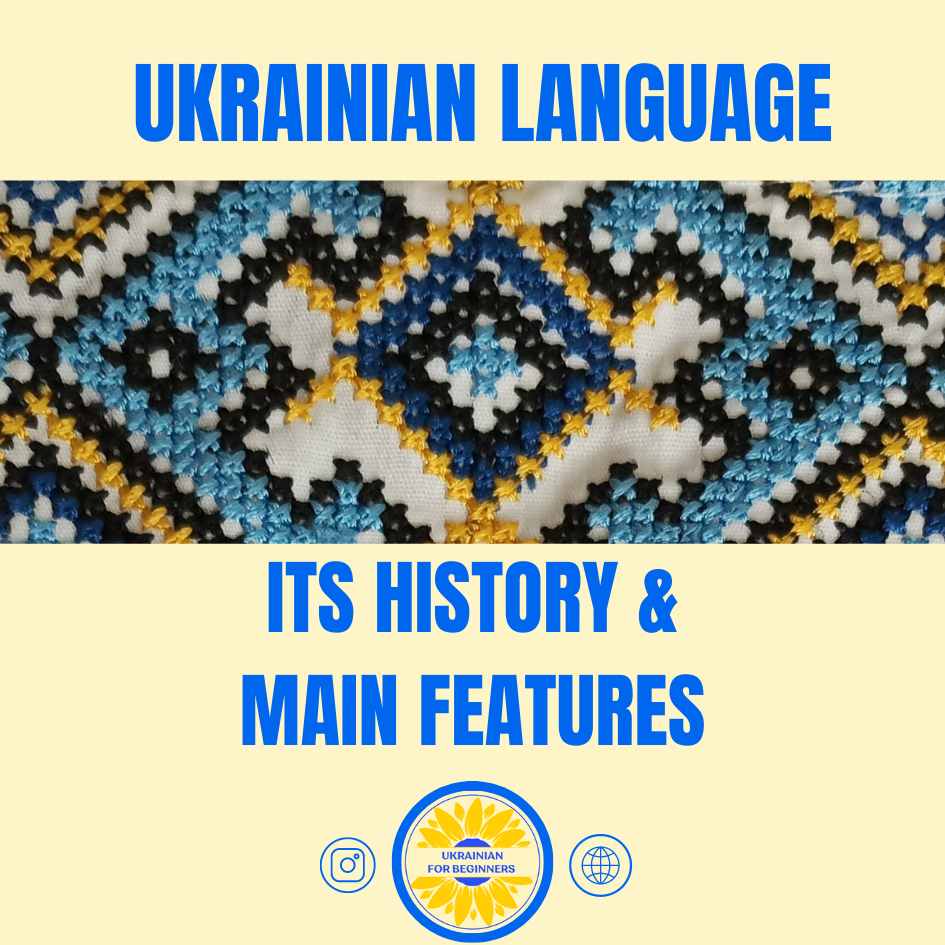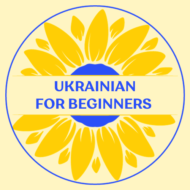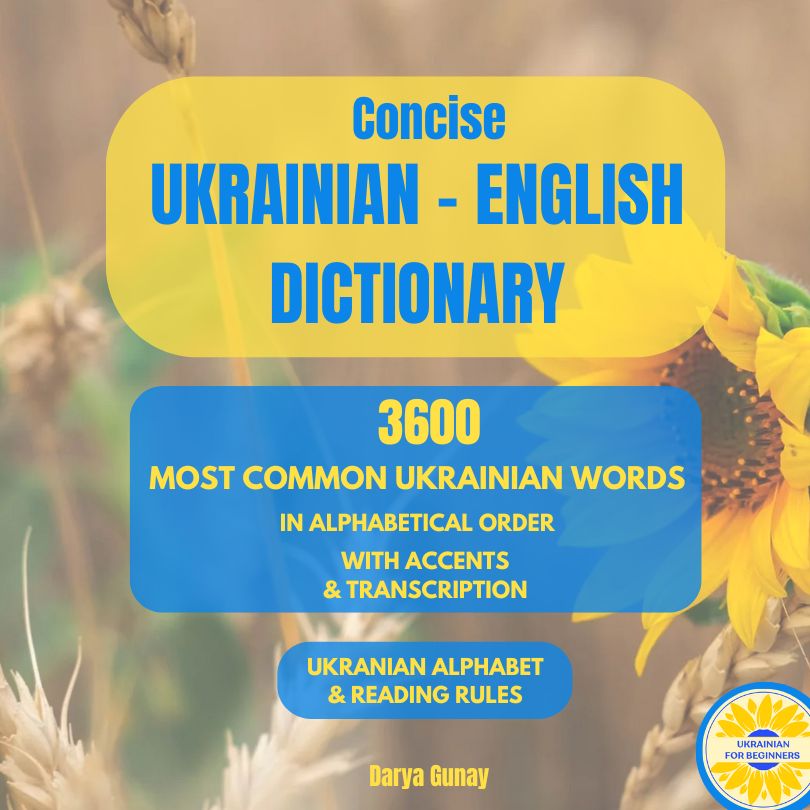
Ukrainian Language – History
Ukrainian language (українська мова) is an East Slavic language of the Indo-European language family.
Ukrainian is close to many other Eastern-European languages (such as Polish, Slovak, Czech, Croatian, Bulgarian etc), therefore if you are already a speaker of those languages you will master Ukrainian much faster. Likewise, Ukrainian will open doors to other Slavic languages for you. Ukrainian has 84% lexical similarity with Belarusian, 70% with Polish, 66% with Slovak, and 62% with Russian.
The first written records of the Ukrainian language
The first written records of the Ukrainian language date back to 448 AD. At that time, the Byzantine historian Priscus of Panium was in the territory of modern Ukraine and wrote down some words that locals were using: “мéд” (honey) and “стрáва” (dish).
Ukrainian or Old Russian?
The name “Ukrainian language” was formed in the 20th century.
Before this, in the Middle Ages, when the Polish-Lithuanian Commonwealth ruled a significant part of the Ukrainian lands, it was called “(Old) Russian language” (давньоруська мова), from the name of the land – Rus (Русь).
Meanwhile, the language of present-day Russia was called “Moscow language” (московська) and “Great Russian Language” (великорусскій языкъ).
After joining the Russian Empire in the 18th century, the Ukrainian language was called “Malorussian” (“Little Russian”), in the sense that it comes from “maloy” (“little”), or “regional”.
Main periods in the history of the Ukrainian language
There are two main periods in the history of the Ukrainian language: Old Ukrainian, which was used from the 15th to the late 17th century; and the new one, from the end of the 17th century to the present.
Ivan Kotlyarevsky (1769-1838), author of the famous poem “Eneida”(1798) laid the foundations of the literary Ukrainian language. Another poet, Taras Shevchenko (1814-1861), had the greatest influence on Ukrainian literature and culture for the years to come.
Kotlyarevsky and Shevchenko’s literary works have great significance to Ukrainian language researchers as both of them were born and raised in central regions of Ukraine and used in their works the spoken language of people living there in those times.
Ukrainian alphabet and regional dialects
The Ukrainian alphabet is based on Cyrillic script, and the spelling of words is the same throughout the modern country.
Cyrillic script with some variations is used in many Slavic (Belorussian, Russian, Serbian, Bulgarian, Macedonian etc) and non-Slavic (Kazakh, Tyva, Adyghe etc) languages.
It is worth mentioning that Western Ukraine was ruled by Poland, Austria-Hungary, the Czech Republic, and Romania until 1939, and the dialects of the Western regions differ significantly from the Eastern ones in their pronunciation and vocabulary, including many borrowings from Western languages.
Ukrainian language of Eastern and Southern regions of Ukraine has been largely influenced by Russian in terms of vocabulary.
Current orthography and grammar rules of the Ukrainian language are fixed in the Ukrainian Pravopys which is updated on a recurrent basis, the latest update is from 2019.
Modern Ukrainian language counts over 250,000 words.
Ukrainian Language – Main Features
The most essential thing to remember about the Ukrainian language is that it is a fusional, or inflected language in its structure.
This language type is also called synthetic due to its tendency to use a single inflectional morpheme (a prefix, a suffix, a word ending) to denote multiple grammatical, syntactic, or semantic features (such as person, number, case, or part of speech).
To compare, modern English can be called partially fusional: it has been losing its inflected features over centuries and evolving as more analytic.
Examples of same-root words in Ukrainian and English:
прáця (work) – умови праці (conditions of work) – працювáти (to work) – я працю́ю (I work) – працівни́к (worker).
Ukrainian words have distinct features (mainly expressed through suffixes and endings) that classify them within a certain part of speech.
For example: вільно is an adverb and вільний is an adjective, you can see that the endings are different.
| ві́льний | vílnyi | adjective | free |
| ві́льно | vílno | adverb | freely |
Conjugation of Ukrainian nouns and adjectives
Aside from fusional structure, it is important to speak about declensions, or conjugation by cases.
Ukrainian words – nouns, pronouns, and adjectives – conjugate by cases. Therefore, in written texts or speech you will notice that the endings of words change. All dictionaries will give you the nominative case of nouns and adjectives.
Most Ukrainian adjectives end in -ий in masculine gender nominative case – the form presented in all the dictionaries.
Keep in mind that Ukrainian adjectives agree in number (singular or plural), gender (masculine, feminine or neuter) and grammatical case with the nouns they describe.
Compare:
ві́льний графік (free schedule) – noun “графік” is Masculine, in Nominative case
ві́льна Україна (free Ukraine) – noun “Україна” is Feminine, in Nominative case
ві́льні люди (free people) – noun “люди” is Plural, in Nominative case
країна ві́льних людей (country of free people) – noun “люди” is Plural, Genitive case
Ukrainian adverbs
Adverbs are the easiest words to learn and search, as they don’t conjugate. A big part of adverbs in Ukrainian end in -o: Я ві́льно розмовля́ю англі́йською (I speak English fluently).
Ukrainian verbs
In Ukrainian, verbs conjugate by persona (I, you, he, they etc).
Verbs also take different inflections when they conjugate by tenses (Present, Past, Future).
Ukrainian verbs also have 2 forms that reflect additional nuances of meaning.
Imperfective aspect form for continuous, habitual actions.
Perfective aspect form for completed or one-time actions.
Two forms may differ in prefixes, suffixes or both.
Dictionaries will give you the most commonly used form in the infinitive (not inflected).
Most verbs end in -ти in the infinitive: ходи́ти (to walk).
Ukrainian language – word order
The order of words in a Ukrainian sentence is flexible (unlike, say, in English, French or German).
The common word order in Ukrainian is
Subject + Verb + Object + Adverbial (all the additional information about place, time, etc).
Я вивча́ю украї́нську мо́ву щодня́. – I study Ukrainian every day.
Inverted word order is quite common: a word/group of words that is emphasized stands in the very beginning.
Щодня я вивчаю українську мову. – Every day I study Ukrainian.
У Львові сьогодні дощ. – Lviv is having rain today.
Не часто можна побачити сніг у квітні. – Not often one can see snow in April.
LATEST POSTS


